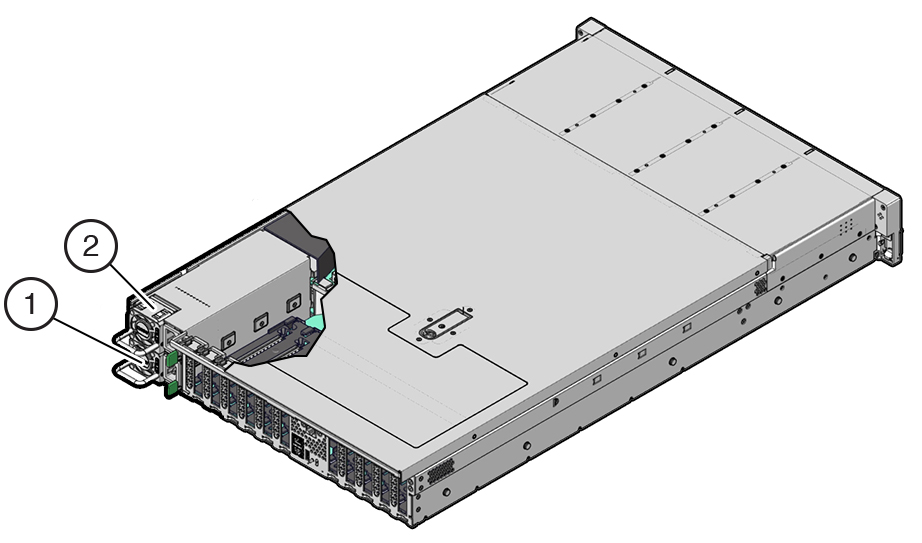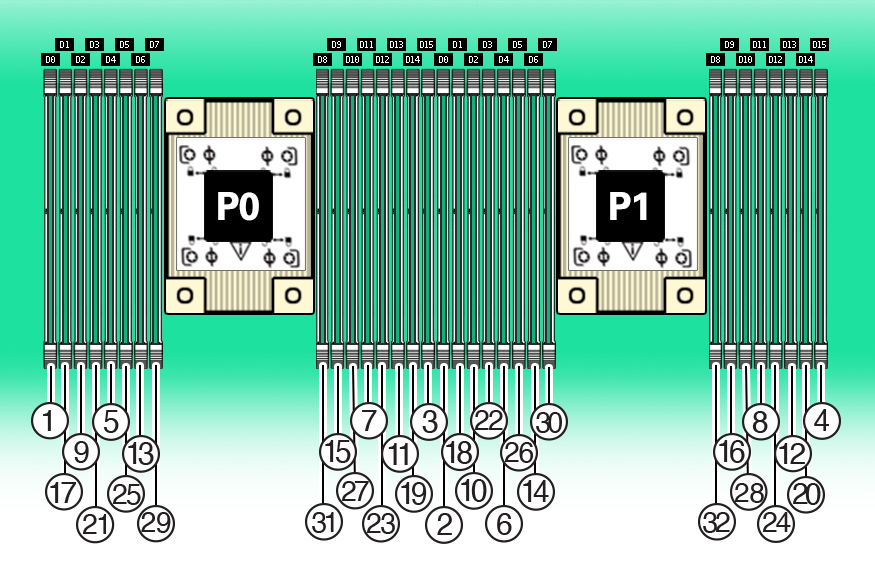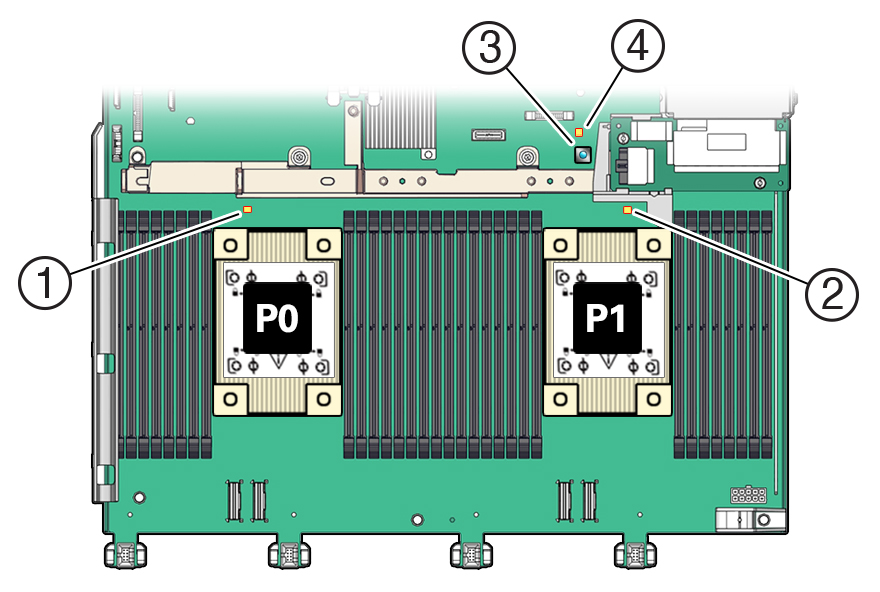Oracle ZFS Storage ZS9-2 Internal Components
The major components of the Oracle ZFS Storage ZS9-2 controller are shown in the following figure and identified in the legend.

|
1 Two system disks, ten filler panels |
8 Processors and heatsinks |
|
2 Disk backplane |
9 Top cover |
|
3 System chassis |
10 PCIe cards |
|
4 Front LED indicator module and temperature sensor |
11 System battery |
|
5 Fan modules |
12 Power supplies |
|
6 Fan tray |
13 Air baffle |
|
7 Motherboard assembly |
14 DIMMs |
Oracle ZFS Storage ZS9-2 Storage Drive
This section shows the location and explains the functions of the storage drive status indicators.

|
1 Ready to Remove (blue) |
2 Service Action Required (amber) |
3 OK/Activity (green) |
Oracle ZFS Storage ZS9-2 Fan Module
The four fan modules are located towards the front of the Oracle ZFS Storage ZS9-2 controller between the CPUs and the drive trays. The fan modules are designated from left to right. As pictured in the following illustration, the four fan modules are designated as: FMO, FM1, FM2, and FM3.

| LED Color and State Meaning |
|---|
|
Amber – The fan module is faulty. The front Top Fan LED and the front and back panel Fault-Service Required LEDs are also lit if the system detects a fan module fault. |
|
Not Illuminated – The fan module is operational (OK). |
Oracle ZFS Storage ZS9-2 Power Supply
The two power supplies are located on the right side of the controller (from the front of the controller) and are designated from top to bottom. The power supplies are accessible from the back of the controller. As indicated in the following drawing, the top designation is PS 1 and the bottom designation is PS 0.

|
1 Power supply 0 |
2 Power supply 1 |
The two power supplies ensure redundancy by allowing the controller to operate when one of the power supplies fails. However, when the controller is operating on one power supply, redundancy no longer exists, and the risk for an unexpected shut down and a loss of data is high. When a power supply or any component that is part of a redundant configuration fails, replace it immediately.

|
1 Power supply (PS) 1 |
|
2 PS 1 status indicators: Fault-Service Required LED: amber; AC power input and DC power output OK LED: green |
|
3 PS 0 |
|
4 PS 0 status indicators: Fault-Service Required LED: amber; AC power input and DC power output OK LED: green |
Oracle ZFS Storage ZS9-2 DIMM
Each processor, P0 and P1, has 16 DIMM slots organized into 8 memory channels. Each memory channel contains two DIMM slots: a black DIMM slot (channel slot 0) and a white DIMM slot (channel slot 1).
The physical layout of the DIMMs and processor(s) is shown in the following figure. When viewing the controller from the front, processor 0 (P0) is on the left.

The following table shows memory channels and their associated DIMM slots.
| Memory Channels | DIMM Slot 0 (Black) | DIMM Slot 1 (White) |
|---|---|---|
|
0 |
D9 |
D8 |
|
1 |
D11 |
D10 |
|
2 |
D13 |
D12 |
|
3 |
D15 |
D14 |
|
4 |
D6 |
D7 |
|
5 |
D4 |
D5 |
|
6 |
D2 |
D3 |
|
7 |
D0 |
D1 |
As shown in the following figure, DIMM slots are labeled D0 through D7 to the left of each processor, and D8 through D15 to the right of each processor. For each processor, the black slots are: D0, D2, D4, D7, D9, D11, D13, and D15. Similarly, for each processor, the white slots are: D1, D3, D5, D6, D8, D10, D12, and D14.

The following table describes the supported memory configurations for Oracle ZFS Storage ZS9-2. The mid-range model supports 8 or 16 DIMMs, and the high-end model supports 32 DIMMs. All DIMMs are 64 GB capacity. The DIMM locations in the table apply to both P0 and P1 processors; for example, P0/D2,P0/D6,P0/D9,P0/D13 and P1/D2,P1/D6,P1/D9,P1/D13.
| Configuration | Total DIMMs Installed | DIMM Slots Populated | DRAM Capacity | Description |
|---|---|---|---|---|
|
Oracle Storage ZS9-2 mid-range model, low-memory configuration |
8 |
D2, D6, D9, D13 |
512 GB |
Black sockets are populated |
|
Oracle Storage ZS9-2 mid-range model, high-memory configuration |
16 |
D2, D6, D9, D13 D3, D7, D8, D12 |
1024 GB |
Black sockets are populated White sockets are populated |
|
Oracle Storage ZS9-2 high-end model |
32 |
D0, D2, D4, D6, D9, D11, D13, D15 D1, D3, D5, D7, D8, D10, D12, D14 |
2048 GB |
Black sockets are populated White sockets are populated |
Oracle ZFS Storage ZS9-2 Storage Drives
Only two of the storage drive slots are used for system boot purposes, which include redundant mirrored drives. These are used and designated consecutively from left, bottom (System Disk 0) to right (System Disk 1). All other storage drive slots include filler panels as is indicated in the following drawing. Drive slots are numbered from left to right, and from bottom to top.

|
1 System Disk 0 |
2 System Disk 1 |
3 Filler panel |
|
4 Filler panel |
5 Filler panel |
6 Filler panel |
|
7 Filler panel |
8 Filler panel |
9 Filler panel |
|
10 Filler panel |
11 Filler panel |
12 Filler panel |
Oracle ZFS Storage ZS9-2 CPUs
The two CPU sockets are located under the air baffle behind the fan modules and ahead of the PCIe slots. As viewed from the front of the controller, the leftmost socket is designated P0 and the rightmost socket is designated P1.
-
If the processor fault LED is off, the processor is operating properly.
-
If the processor fault LED is on (amber), the processor has failed and must be replaced.

|
1 Processor 0 fault LED |
3 Fault Remind button |
|
2 Processor 1 fault LED |
4 Fault Remind circuit good LED |